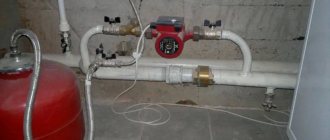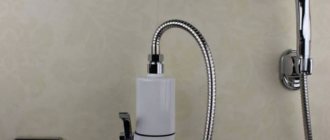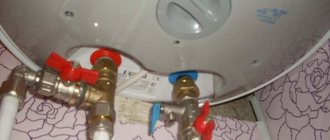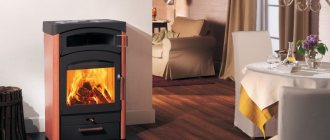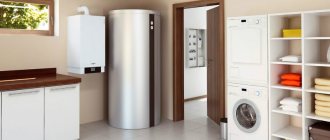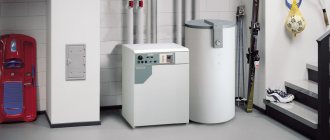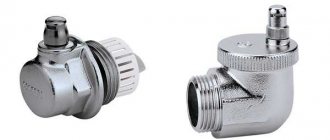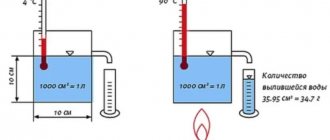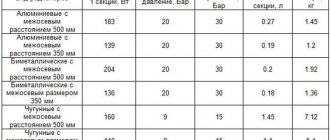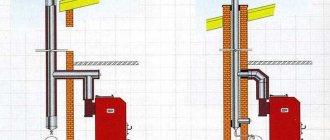When buying a country house or cottage, an important issue arises - providing the home with hot water, since not all settlements are connected to a centralized hot water supply network. Installing a water heater solves this problem and provides comfortable living conditions. A modern device is capable of uninterruptedly supplying hot water so that its owner always has the opportunity to enjoy all the benefits of civilization.
Storage water heater Source kanalizaciyadoma.com
Types of water heaters by heating method
Based on the heating method, devices are classified into flow-through and storage, which have their own pros and cons. The choice in favor of one device or another depends on the personal preferences of the owners of suburban real estate, the volume of hot water consumed, and the free space for installation.
Cumulative
The design of the heater, installed mainly in the bathroom, provides for its own capacity. The principle of operation is simple: the tank is filled with water from the water supply, which is heated by a heating element. When the set heating temperature is reached, the automatic switches off the device.
The flow of hot water into the pipe is ensured by high pressure of unheated water. The pipes are placed so that layers of liquids with different temperatures do not mix with each other inside the heater. This allows you to maintain the set coolant temperature within 50-70% of the volume until the next batch of cold water arrives.
Design of a storage water heater Source optolov.ru
The advantages of installing a boiler of this type include:
- No need for a powerful power source.
- Gradual heating of water.
- Construction with insulated walls. Thanks to this, it is possible to turn on the device during the period of economical electricity tariffs and use hot water at any time of the day.
The main parameter influencing the choice of a particular storage water heater model is the volume of the tank. The capacity of the tank is selected depending on the daily consumption of warm (mixed) water per adult living in the house. The need is something like this:
- for hygiene needs – 20 l;
- for household needs - 12 l.
Thus, the water heater is selected based on the following considerations:
- family of two – 50-80 l;
- 3 people – 80-100 l;
- 4 residents – 100-120 l;
- 5 family members – 120-150 l.
Water consumption table Source otivent.com
Instantaneous water heaters
The principle of operation of the devices is inherent in the name itself. There is no storage tank in such devices: the liquid circulates next to the heating element or is in direct contact with it.
The power of the device should be enough to heat water to a user-defined temperature in a short path through the heating element. To connect an instantaneous water heater to the home electrical network, a powerful line is required - during operation, the load on the network increases sharply.
At the same time, manufacturers have found a kind of compromise: high power is offset by the compactness of the devices. Otherwise, to reduce the load, a significant increase in the volume of the heat exchanger is necessary - too much installation space will be required and the main advantage - compactness - will be lost.
Design of instantaneous water heater Source kabel-house.ru
Another advantage of instantaneous water heaters is the supply of heated water without delay. Storage devices need time to warm up the liquid entering the tank, and there are also certain temperature losses during its storage. Installing a instantaneous water heater allows you to use hot water at any time.
In terms of efficiency, devices of one type or another have no fundamental advantage. To heat the same amount of water, both storage and flow-through devices will require approximately the same amount of electricity.
Electric water heater device
Plumbing Electrical circuit of a water heater Hot water supply provides comfortable living conditions for a modern person. Installation of water heaters must be carried out in accordance with the markings indicated on the body of the water heater: Marking.
Here the difference is noticeable; for flow-through ones the price is rubles. Economical: in addition to heating the water itself, electricity is spent to compensate for heat loss through the insulation layer of the tank.
Familiarize yourself with the existing nuances to get the job done as efficiently as possible. The connection is made from the thermostat output terminals.
This is done due to the small diameter of the fitting, to which only a rubber hose with a small cross-section can be attached.
At this moment, the transistor VT1 opens and the control electrode of the power thyristor VS1 is shunted to the minus of the circuit, from which it was previously separated by a voltage drop across the resistance of resistor R4.
This chain is configured so that with a current through the primary winding of 30A, a voltage of 45 volts is generated on the capacitor. The RCD and the automatic circuit breaker perform protective functions: the RCD eliminates the possibility of electric shock in the event of a leak, when the insulation is damaged or a breakdown occurs in the housing; Using a circuit breaker, the network is protected from overloads and short circuits.
The PE neutral protective conductor is connected to the tank body using a special screw. 21 Hot water recirculation scheme
We recommend: Energy efficiency analysis of buildings
Selecting a model and location
When selecting a water heater model, it is necessary to take into account the main technical characteristics and parameters:
- Productivity . An optimally selected heater will allow the owner to constantly receive the required volume of hot water at the lowest cost.
- Power . This indicator is more important for storage devices. High power significantly speeds up water heating, but complicates installation. Increased load on the home electrical network leads to its damage or to automatic operation.
Electrical connection Source electricisrael.com
See also: Catalog of companies that specialize in engineering systems, water supply and sewerage.
- Dimensions . Instantaneous water heaters are quite compact, while the dimensions of storage devices directly depend on the volume of the tank. When choosing a boiler, you should decide in advance on its location and compare the dimensions of the installation area with the dimensions of the device.
- Weight . Storage water heaters are mainly mounted on the wall, so when selecting a model, it is necessary to determine the total weight of the device, taking into account its filling with liquid.
Installation of devices is carried out:
- vertical;
- horizontally;
- on the floor;
- with wall mounting.
The choice of one of the installation methods is determined by the wishes of the owners and the permissibility of placement in a particular place.
Water heater on the wall in the bathroom Source sovet-ingenera.com
Before installing a water heater, it is important to determine the strength characteristics of the material from which the wall is constructed and whether it will withstand the load from the attached device.
When choosing a location, you should ensure:
- convenient connection and maintenance during operation;
- the most comfortable location;
- ease of setup and operation management;
- accessibility of control and switching on/off of the device.
It is also necessary to provide for possible leakage of the device and place it at a point where the consequences of an accident will be minimal and quickly eliminated.
Installation Rules
If you decide to install the boiler yourself, then you need to clearly know how to do it. Mistakes made during installation will lead to burnt out wiring, flooding of the home, and failure of the device. Let's consider the basic rules for installing a water heater:
- First you need to choose the optimal location of the device. The boiler is usually installed in the bathroom, toilet or kitchen. Electrical appliances are provided with free access.
- The wall or any other support for the boiler must withstand double the weight, for example, with a capacity of 80 liters, the load indicator is 160 kg.
- Old wiring must be replaced, otherwise it simply will not withstand the load.
- The wiring of ten-year-old metal pipes will similarly have to be changed.
Other rules and installation nuances will be specified in the installation instructions.
Connection to water supply
The choice of one or another method of connecting the boiler to the water supply is determined by the material of the pipes and the layout of their installation throughout the house.
Polypropylene pipes
Connection to PP pipes is carried out using a special soldering iron and pipe cutter. For pipe routing, the master uses tees made of polypropylene, and the tap is installed using an MPH coupling.
Connecting a water heater to PP pipes Source remontstroy.net
The connection itself with external wiring does not create any difficulties. If the pipes are hidden under decorative panels, before connecting the boiler, the technician opens the casing layer.
Recommendations from the pros!
Accessories for a bath Do-it-yourself gazebo Concrete fence Do-it-yourself potbelly stove Do-it-yourself veranda Screw foundation Do-it-yourself country toilet Decorative brick Stone fence Pouring a foundation How to make a fence Wicket from corrugated sheets Do-it-yourself fireplace Brick fence Do-it-yourself flower beds Forged gates Do-it-yourself porch Pool for a bathhouse Chicken coop do it yourself DIY staircase Metal gates Installation of lining Installation of polycarbonate Pump for a summer house Arrangement of a garage Fences for flower beds Do-it-yourself blind area Steam room in a bathhouse Railings for stairs Do-it-yourself cellar Painting walls Press with your own hands Grilles on windows Rolling gates Do-it-yourself barn Alarm system for a summer residence Benches for a summer residence Fence posts Floor screed Solid fuel boilers DIY greenhouse Fence installation House insulation Attic insulation Foundation insulation
Connecting the storage heater
When installing a storage water heater, the technician must use a non-return safety valve, which ensures the correct functioning of the device and reduces the risk of unforeseen situations.
Mounted safety valve Source hi.decorexpro.com
What is not recommended to do
How to install a boiler correctly was discussed above. But there are recommendations on what to do during installation and use of the unit:
- turn on the installed unit, not filled with water;
- connect a pipe from the water main to the water heater if the pressure in it is more than 6 atmospheres;
- remove the protective cover of the unit and drain the liquid from it without disconnecting it from the power supply;
- engage in installation if you do not know how to install a boiler with your own hands;
- the use of “left” components different from those recommended by the manufacturer;
- When installing the unit, ignore the installation of the safety valve;
- do not follow installation and safety rules.
Video description
In the video about how the water heater is installed:
When connecting a storage type water heater, the technician installs the connecting parts in this order (in the direction from the inlet fitting):
- tee-clip;
- ball valve, connected to the side branch of the holder and used to drain liquid;
- safety valve with drainage outlet;
- shut-off valves (valve) used to turn off/on water;
- pipe.
If connection conditions require, the wizard can supplement the diagram:
- Gearbox . The device is used to reduce the incoming pressure to that set by the manufacturer for a specific water heater model.
- Filter . Installed when tap water does not meet the requirements that ensure normal functioning of the boiler. The presence of an excessive amount of salts and insoluble substances in water causes the formation of deposits on the inner surface of the storage tank and heating element.
Connecting a water heater using a polyphosphate filter Source www.stroyportal.ru
Upon completion of installation, the master connects a pipe that supplies flammable water to consumers to the supply pipeline. A shut-off valve is installed on the required branch pipe of the device, ensuring quick shutdown. To transfer heated water, the tap is connected to a flexible hose.
Storage water heater is ready for use Source smartremstroy.ru
Turning on and checking the boiler after installation
Upon completion of the installation and connection of the water heater, the last question remains - how to check the device for operation:
- after the risers, close the hot water tap and open the cold water tap;
- at the boiler inlet, open the shut-off valves and the hot water tap of the mixer;
- under pressure, water will fill the tank, displacing air from the system through an open mixer;
- when the water pressure flows continuously without air pops, close the mixer tap.
The device is under pressure. All that remains is to check all joints for leaks.
After successful filling with water, voltage is applied to the water heating device and the desired operating mode is set. The heating time depends on the power of the heating element and the capacity of the tank. If after about 1 hour hot water appears from the mixer, the installation has been carried out correctly.
Connecting an instantaneous water heater
Before connecting an instantaneous water heater, you must accurately determine the number of points it serves; based on their number, productivity and power are selected, and the location of the device is determined.
The simplest scheme - to one tap, allows you to purchase a low-power, inexpensive boiler with low productivity. In practice, in individual houses, more complex schemes are used with the creation of at least two pipe outlets - for faucets in the kitchen and bathroom, for which a more expensive and powerful device with high performance is purchased. The location is selected in such a way that the device is located approximately at the same distance from all serviced points.
Connection diagram for instantaneous water heater Source sv.decorexpro.com
Craftsmen perform installation in the following sequence:
- Tees are cut into cold and hot water pipes to connect all elements.
- Ball valves are mounted on the fittings, providing, if necessary, the ability to stop the flow of liquid into the device. For example, when using the device as an additional device (the house is connected to a central hot water supply network), turning off the tap makes it possible to use water from the system.
- Tees placed on the pipes are connected to suitable water heater pipes through bendable hoses. When the device is located at a considerable distance from the insertion points, pipe sections can be additionally used - PP, steel, metal-plastic (in accordance with the material of the water supply system.)
Before connecting a flow-type water heater, the technician must determine the need to install a mechanical cleaning filter and a gearbox, the same as for a storage device.
Instantaneous water heater prepared for operation Source ogodom.ru
How to make it yourself
For those who like to do something with their own hands or have a technical education, it will not be difficult to make a flow-through boiler.
The simple design itself is repairable and productive - all this is possible for budget money. A homemade instantaneous boiler is installed by bending the spiral of a pancake around an electric stove or gas burner.
To make a water heater at home you will need:
- The pipe is made of copper, since copper is an excellent heat conductor. Sometimes they use nichrome wire, winding it several times.
Please note: the length of the pipe does not affect the amount of heat transferred from the source, so in this case it is not necessary to clutter the structure with additional rings
- Rubber hose (preferably new).
- Rubber gaskets matching the diameter of the hose and metal clamps.
In order to do everything correctly and safely, you need to familiarize yourself with the technical documentation of the electric (gas) stove and determine its potential.
Progress:
- Measure the diameter of the electric stove or burner pancake.
- Bend the copper pipe into a spiral with a diameter slightly larger than the diameter of the stove so that the spiral outlets protrude 20-30 cm from the stove. It is necessary that the spiral fits tightly to the base of the slab and does not have any distortions. Make sure the spiral has straight, smooth edges.
- Secure the spiral using the brackets and bolts (you can use another fastening hardware to secure it).
- Connect a rubber hose to the spiral outlets and secure it with a metal clamp.
- Connect the other end of the hose to the faucet and install it along the sink.
- Turn on the water and check the operation of the system for leaks.
It is important to know: before turning off the water, you must first turn off the heating element. If you do the opposite, the spiral may burn out. Keep in mind that the lower the pressure of the flowing water, the hotter it is.
Keep in mind that the lower the pressure of the flowing water, the hotter it is.
If the coil overheats, do not turn on the water - this can lead to rupture of the metal. Turn off the gas (electricity) and give the metal some time to cool.
All parameters can be varied, since, in fact, a homemade boiler is based on the potential and capabilities of a gas or electric stove.
Security
To connect powerful models of storage-type water heaters to the electrical network, craftsmen use a reinforced cable with three cores, which is laid directly from the distribution board. Installation of a double circuit breaker or RCD and grounding are required.
Connection to the electrical network Source otopleniesam.ru
Manufacturing of a device operating from the heating system
How to make an instantaneous water heater with your own hands that operates from the heating system? The basis of operation of this unit is the heating of the heat exchanger by a coil, which is placed in the hot coolant of the heating system. A heat accumulator can play its role.
However, inserting such a coil into a new heat accumulator will lead to a bad result. You can cause damage to the insulation, which will dramatically reduce the level of efficiency. You should make your own heat accumulator. The device must be small in size. Then a heat exchanger is cut into it, and the entire structure is insulated.
